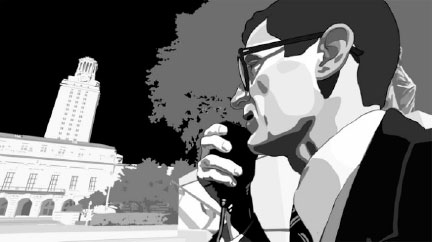 |
 |
| About | Cinema | Articles | Art | Consultations | Events | Cirillino | Music | Reportage | Curated Contributions | |
|
Frank Serpico (2017) by Antonino D’Ambrosio
“Tower” directed by Keith Maitland (2016)
On Aug 1st 1966 at 11:48am at the University Of Texas in Austin, shots rang out from the 27th floor of the clock tower onto the campus plaza below. Students and passersby reacted slowly at first to the rifle reports, not sure of the source of the sounds or aware of the fact that a sniper was deliberately targeting people. In 96 minutes, for what must have seemed an eternity, 31 people were wounded and 16 were killed. Keith Maitland’s documentary “Tower” is an animated account of those long 96 minutes of terror and successfully transports the audience to that scorching 100 degree day in 1966. The film focuses on Claire Wilson, an eighteen year old anthropology student. Claire and her boyfriend, Tom Eckman, are both shot down as they walked hand in hand across the campus. Tom dies instantly while Claire who is six months pregnant, lay gravely wounded in the searing heat, her unborn child killed by the gunshot to her abdomen. The film switches briefly from stark black and white into color evoking Claire’s hopes and dreams of a family with Tom, and the sudden shattering of her future. Using rotoscopic animation, archival footage and live radio broadcasts, Maitland weaves together the lives of the victims and the heroic actions of fellow students: Rita Starpattern makes her way to Claire and risking her own life, lays in full view of the sniper in an attempt to assist her but is soon facedown on the scorching cement as well. John ‘’Artly’’ Fox and his friend James Love, who after cowering behind the statue of Jefferson Davis, summon the courage to sprint across the plaza and carry Claire to safety. The shooter – Charles Whitman, is not portrayed in the film. Rather he is seen in a LIFE magazine article following the massacre, as a young child holding two rifles, himself a victim of the culture of violence that destroyed so many lives that awful day. The same gun mania and seemingly weekly carnage so prevalent today, is featured in news clips of now infamous mass shootings such as Columbine and Newtown. The central character in the film is in fact the Tower itself. A gigantic and faceless symbol of power raining death down upon innocent victims. In news footage shot that day as the slaughter unfolded, puffs of smoke can be seen emanating from the observation deck giving the impression that the tower itself is the source of the senseless horror unfolding on the campus. The murder and mayhem in Austin that afternoon had deep repercussions. It gave rise to SWAT teams across the nation and the militarized police response now common in our nation can be traced back to that day. Live radio reports from the scene were flashed across the country foreshadowing the CNN effect and instantaneous speed in which events unfold and are now reported via social media online. Incredibly, Claire Wilson, despite the loss of her unborn child and boyfriend, has forgiven the shooter whom she regards as a victim of the madness of this nation’s obsession with firearms and violence. Others, such as Artly remain haunted by the events and speak openly about them for the first time in this film. A testimony to the power of documentary film, the release of “Tower” spurred an about face from the university who after five decades erected a memorial to the victims and heroes of that day in a public ceremony on the 50th anniversary of the shootings.
|
| © copyright 2016, 2017, 2018, 2019, 2020, 2021, Wildside Media. All rights reserved | |
